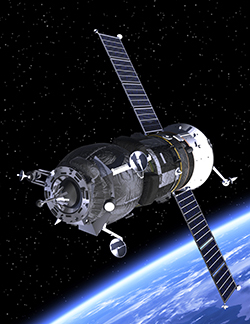Boosting Satcom Ground Segment Feasibility with AI
By: David Gibbons

The ground segment is a complicated beast that is undergoing a lot of change. Cloudification, virtualisation, and today’s established and emerging networks in Non-Geostationary Orbit (NGSO) are increasing that complexity. It’s also a numbers game, where ground stations must drive profitability. A November 2024 report on the ground segment by Novaspace, Ground Segment Market Prospects, revealed that, between 2023 and 2032, the cumulative market value of the global ground segment will rise to US$8 billion by 2033, and that there will be a 2.3 times growth in the number of commercial user terminals between 2022 and 2033 to 3.2 billion. As far as the ground station market is concerned, Global Market Insights predicts huge growth from US$53.8 billion in 2024 to US$176.6 billion in 2034. That’s a CAGR of 12.8%.
What’s Driving the Growth?
This demand for the ground segment is being stoked by the increase in NGSO constellations, driven by the likes of Starlink and increasing amounts of other NGSO constellations. Still, it’s also down to a range of other notable industry trends. The data boom has pushed operators up into the higher frequency bands with HTS and VHTS that deliver more than twenty times the data capacity of traditional satellites at a fraction of the cost per bit. As with LEO constellations, activity in these higher bands, such as Ka- and Q/V- results in the need for a much larger number of gateways in the magnitude of tens or hundreds.
There has also been a rapid expansion of the ground segment in emerging markets as they strive to develop their own satellite programmes and respond to the growing requirement for satellite services. Add to this a burgeoning demand for multi-frequency ground stations to support a range of different applications from earth observation and remote sensing to communications on land, sea, and air. LEO traffic is exploding, and this is creating huge demand for hundreds of thousands of ground stations to manage higher traffic volumes and to offer global coverage. This is all set against a backdrop of geopolitical uncertainty, which is spurring governments to initiate national satellite programmes that will help ensure communications sovereignty.
The ground station market is an expensive one that involves a great amount of infrastructure and the upkeep of this is challenging and expensive. As satellite operators strive to deliver more at less cost, this can pose significant challenges. Regulatory requirements from an environmental and cybersecurity perspective influence the design of ground infrastructure and also push costs up.
Moreover, it is critical that each ground station operates smoothly, and that downtime is avoided so that RoI can be maximised. This is especially important for the ground stations and terminals that utiise the higher frequency bands. They are particularly sensitive to the impact of weather, especially precipitation which can negate a satellite link and potentially bring it down completely.
Where Does AI Fit In?
Competition is increasing, and this is driving innovation; at the same time, there is also rapid advancement in AI. While there’s a great deal of talk about AI in satcom, adoption is probably
slower than in some other sectors. Although some satcom tools are already utilising AI, primarily in the ground segment, it is really still in the very early stages of deployment.
For satellite operators, efficiency is critical. Each gateway is costly and must be optimised to avoid downtime, as this carries a financial impact. Coordinating and operating the ground segment
also carries high costs. To do so efficiently, data must be gathered and processed in real-time to glean a true picture of performance. Fortunately, this is one area where AI is already making a
big impact, supporting operators with site qualification, network design, coordinating gateways, and predicting downtime.
AI Use in Site Qualification and Network Design
Networks must be designed with efficiency in mind, right from the very beginning, in terms of how many gateways and diversity gateways are required, where each of these gateways is located for best availability, taking into account the impact of weather, and establishing the optimum link budget/fade margin and optimum gain for each gateway antenna.
Weather patterns are of particular relevance for networks employing higher frequency bands such as Ka-band and Q/V-band because these bands are highly susceptible to attenuation caused by precipitation. To determine the influence of weather on candidate ground station locations, it’s necessary to take into account historical weather data. Traditionally, determining the optimal number and location



















